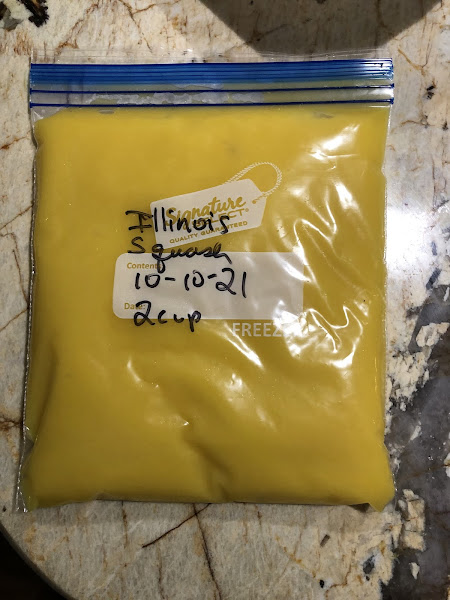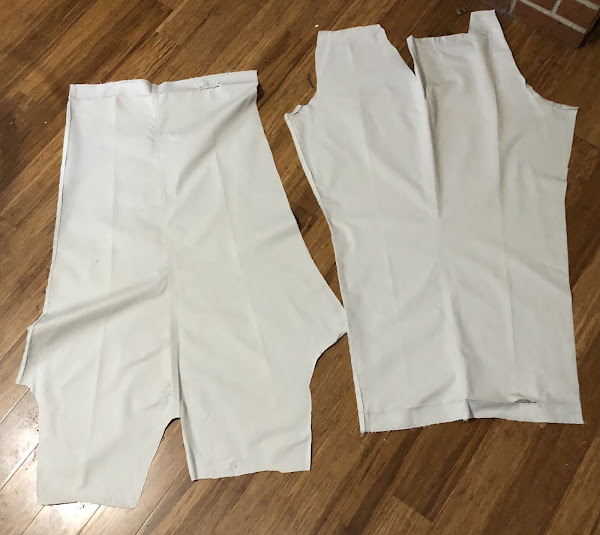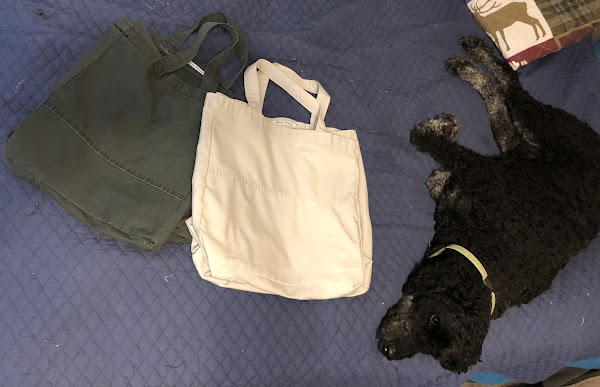Wednesday, October 20, 2021
Cooking a Jumbo Size "Illinois" Squash. 10.20.2021
This week I butchered an Illinois squash and made several things from it. There wasn't much wasted.
The back story of this open-pollinated variety is that Abraham Lincoln's family bought the seeds when they lived in Kentucky. When they moved to Illinois, they took seeds along for the move. They grew these in New Salem. Seeds were given or sold to neighbor families, some of whom grew them for generations, passing the seeds down to their descendants. Finally, some seeds wound up with seed merchants, and I bought these from rareseeds.com.
This is a moschata species squash, and all of my other squashes were ither species, so they should grow true from saved seeds.
This squash was 18 pounds. It was way to big to roast without making some slices.
I set aside one one-pound section to be included as 1-inch cubes in the next 8-day supply of dog food, and a 2-cup portion of cubes for the day's squash soup. The rest were roasted at 375 F for 90 minutes until tender. Then I scooped out or sliced off the toased flesh and pureed for future soups or pies.
This squash came out lemon yellow. I froze 6 2-cup freezer bags of puree for future use. I also rinsed off the seeds and let them dry to save for next year.
I did make a pie with one bag of puree. Despite being lemon yellow, the pie came out a rich chestnut brown. The recipe is the same as pumpkin pie, except I substitute coconut milk for evaporated milk. Very tasty pie for sure.
Sewing Upcycled Chinos Grocery Totes. 10.29.2021
Ning had some chinos that he wore at work before retiring, and no longer wears. they are a good quality, rugged fabric. The cuffs were frayed and there was wear on the beltline. The rest of the fabric is tough and undamaged. With new Washington State requirements to stop one-use plastic bags at grocery stores, I decided to make some totes he can keep in his car for shopping trips. I already have some like these in my car.
The pattern was an old tote from the era when they were made with thinner plastuc than new ones. The size and shape are almost exactly the same as a large brown paper grocery bag.
First, cut off the belt line and zipper, and cut the inseams to open the fabric panels.
Then measure out how the bag panels will fit together. They usually require some piecing for the end / bottom panel.
I finally changed the long panel to three shorter cross-wise rectangles, which I pieced together to make a single long section. That worked better with these fabric sections.
Then I piece together the bagand handles. It's all the same shape as the original, old bags although I give it an extra inch in every direction for size. The handles are also made the same as the original bags.
I think this uses about 90% if the fabric from the original chinos. There might be enough remaining to make a cadet cap, I'm not sure. It would be good fabric for that. These bags are highly durable and strong. By upcycling cotton fabric, there is no environmental issue involving the high impact of virgin cotton. One tote holds as much as four disposable one-use plastic begs would hold, without tearing. They are clothing, so can be washed and dried exactly the same as the original trousers, as needed. Store bought canvas totes shrink like crazy when washed. These are highly ore-washed already. They won't shrink at all. I've used denim but it's rough on my sewing machine. The chino cotton is still heavy, but not as heavy as denim, so it sews without any problems. The photo is 2 totes. There are two more to be made, but not for a while.
Edit 11.9.21 Here are the dimensions for the bad, not necessarily to scale.
Planning a Table Top Quilt for Fall. 10.20.2021
This is for Ning's dumpling rolling table. He uses a coffee table and sits at the couch to roll out dumplings. I thought it would be nice to have a padded and washable surface, with the rolling board to sit on top.
These are from a fabric sampler fabric strip roll that I bought on close out sale on the internet. I sewednthe 2 1/2" strips together in groups of three, then cut the result wide strips into 6 1/2 inch squares. With a 1/4 inch seam allowance, the final squares are 6". Here they are laid out on the kitchen island.
It's nice taking a cellphone photo so I can reassemble the peices in the pattern I laid out here. Also, the cellphone photo seems to sharpen oatterns that I might otherwise miss. This pattern, with the 3-strip group being darker-medium-lighter, and laid at right angles to one another, is called rail fence. It's a traditional pattern. It takes some trial and error to arrange and rearrange them so no unwanted patterns emerge by accident.
This auilt should go together fairly quickly. I already have fabric samples that I'll sew together to make the backing, and enough batting on hand from previous projects.
Planting an Apple Seedling from Calypso™ X Golden Sentinel™
Last year I pollinated some Redlove™ Calypso™ blossoms with pollen from a Golden Sentinel apple tree. The goal was to see if seedlings would have red flesh apple traits but columnar shape tree. From the seedlings, twomhad red leaves, so I'm confident the apples will have red flesh. Both might have columnar shape. It's too early to say. This one has not made branchlets yet, unlike the other two. It does appear to have a blossom spur, even though it seems early for that.
Sunday, October 10, 2021
(Pink Banana) Squash Soup. 10.10.21
I placed Pink Banana in parentheses because it's squash, not bananas, and it's not all that pink.
This soup was:
2 tablespoons unrefined coconut oil.
2 1/2 cups of squash cubes, after peeling and removing fibrous stuff from inside the squash. That's about 1/4 of this particular squash.
1/4 large onion, cut into chunks
1 big garlic clove or two smaller ones
1 vegetarian buillon cube. I like Knorr.
2 cups of water
plus decorations (see below).
Saute the onion and garlic in the coconut oil.
When those are clear and just barely starting to brown, add the water and squash and chopped buillon cube.
Bring to a boil.
Simmer 20 min, until the squash starts to soften up.
Turn off the burner.
Use an immersion blender to puree the soup.
Portion into bowls.
Add chopped peanuts and dollops of Sambal Olek or Sriracha sauce.
What I liked about this soup-
The squash is a mild flavor. However, I've done this with pumpkin instead, and that was very tasty too.
The coconut oil added a nice coconut flavor to the soup.
The chopped peanuts give some texture and flavor that matches perfectly with the soup.
The Sriracha (actually my home made version) isn't uniformly mixed with the soup, so there are portions that have the rich hot pepper flavor, and others without it. It's a nice diversion within the bowl of soup.
I make a similar soup with sauce tomatoes instead of squash. That's a different blog entry, but basically it's substitute about 4 cups chopped tomatoes for the squash and water, add 1/2 tsp of Italian herbs, and garnish is oregano and croutons.
Subscribe to:
Posts (Atom)

















